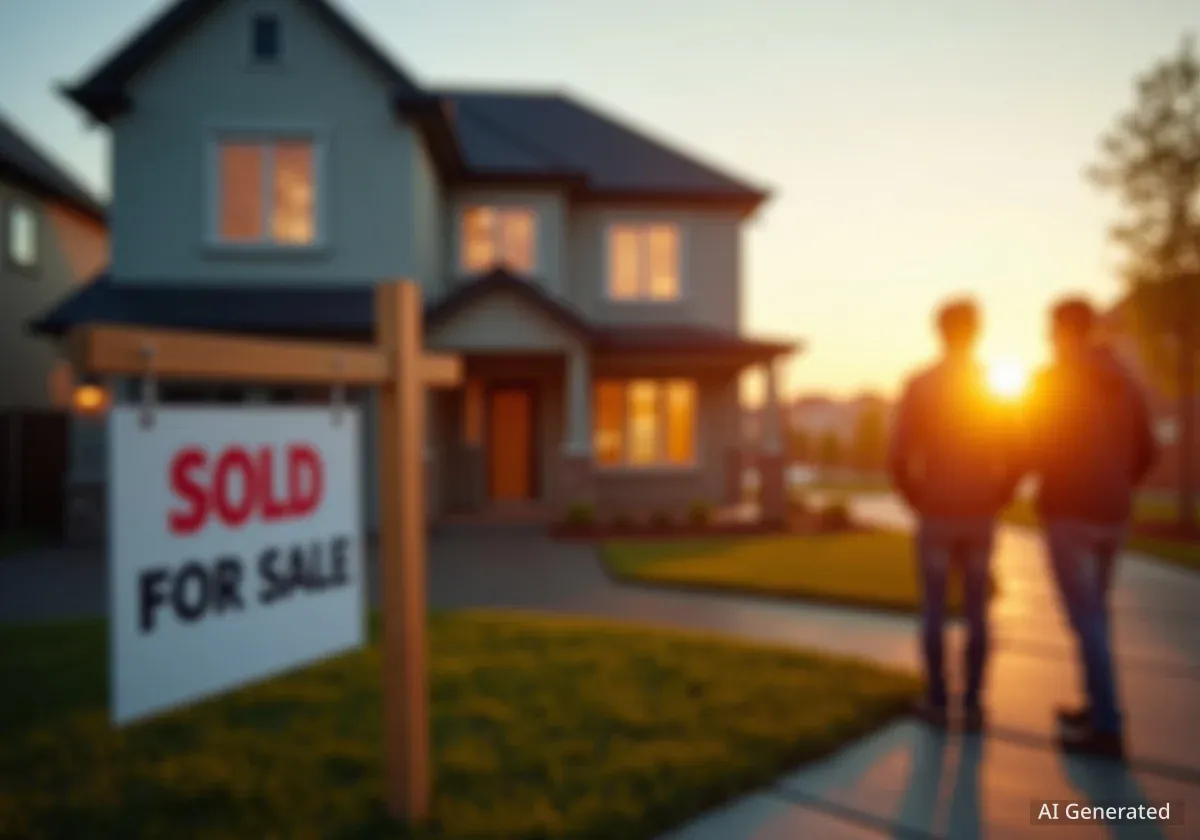A new initiative in Utah aims to address the critical shortage of affordable housing by building 35,000 starter homes, offering a potential path to ownership for young families facing record-high prices. However, with demand far exceeding the current pace of construction, the program highlights the broader challenges facing first-time buyers across the United States.
For Miranda and Cole Potokar, a young couple in Utah, the dream of owning a home seemed impossible as prices soared. After years of saving while living in a relative's basement, they secured a home through the state's new development plan, illustrating both the program's potential for success and the intense competition for affordable properties.
Key Takeaways
- Utah has launched an initiative to build 35,000 affordable starter homes over five years to combat rising housing costs.
- Despite the program, only about 5,100 homes have been completed or started, while demand remains extremely high.
- The average U.S. home price is approximately $363,000, but in Utah, it exceeds $529,000, reflecting localized market pressures.
- Nationally, the U.S. faces a housing shortfall of nearly 5 million homes, pushing the median age of a first-time buyer to a record high of 38.
A Glimmer of Hope in a Difficult Market
For many young Americans, rising housing prices have pushed homeownership out of reach. Miranda and Cole Potokar, aged 23 and 24, experienced this firsthand in Utah's competitive market. After marrying two years ago, they moved into her grandparents' basement to save money, but every home they considered was sold before they could make an offer.
Their situation changed when they qualified for a new home in a development north of Salt Lake City. This project is part of Governor Spencer Cox's ambitious plan to create 35,000 lower-cost starter homes within five years. The couple purchased a 1,400-square-foot, two-story house for under $400,000, a figure significantly below the state's average.
Cole Potokar described the opportunity as a crucial chance at stability. "It's a base not only for our family, but also to set us up for the future," he said in an interview with NPR. Their story represents a success for the state's initiative, which uses low-interest construction loans to incentivize builders.
However, the Potokars' success is not yet the norm. The builder, Nilson Homes, reports a massive waitlist for these properties. As of May, only about 5,100 of the targeted 35,000 homes have been built or are under construction, indicating a significant gap between the program's goals and its current progress.
The National Housing Affordability Crisis
Utah's housing challenges are a reflection of a nationwide trend. The affordability of starter homes, once a key milestone for young adults, has significantly declined. This issue is driven by a combination of economic factors that have been developing for over a decade.
By the Numbers: The U.S. Housing Market
- National Average Home Price: $363,000
- Utah Average Home Price: $529,260
- Median Age of First-Time Buyer (2024): 38
- Median Age of First-Time Buyer (2023): 35
- National Housing Shortfall: Nearly 5 million homes
Sources: Zillow, National Association of Realtors
According to the National Association of Realtors, the median age of a first-time homebuyer in the U.S. rose to 38 in 2024, up from 35 just one year prior. For many in younger generations, purchasing a home is no longer an early life achievement but a midlife financial goal.
Deep-Rooted Causes of the Shortage
Experts point to several persistent factors contributing to the housing shortage. The primary cause is years of underbuilding following the 2008 financial crisis, which created a deficit of nearly 5 million homes nationwide. In states like Utah, this problem is made worse by rapid population growth and larger-than-average family sizes.
Restrictive local zoning laws often add another barrier. Many municipalities mandate large lot sizes, such as a quarter-acre minimum, which incentivizes developers to build larger, more expensive luxury homes instead of smaller, affordable ones. Andra Ghent, a finance professor at the University of Utah, noted the impact of these regulations.
"If developers are stuck with that minimum lot size, they’re going to build luxury homes," Ghent told NPR. She added that she has not seen "concrete steps that would really move the needle right now."
High inflation and elevated interest rates have further strained affordability, making it difficult for even dual-income households to qualify for a mortgage. The combination of limited supply and high financing costs has priced a large segment of the population out of the market.
Policy Solutions and State-Level Efforts
Recognizing the severity of the housing crisis, some states are taking legislative action to increase supply. Utah's program is one of the most ambitious, but it is not alone. States like California and Oregon have passed laws to override local zoning restrictions, allowing for denser housing development.
Even Texas, a state known for its expansive development, has recently loosened zoning codes to permit smaller lot sizes. These policy shifts signal a growing consensus that without changes to land-use regulations, the housing market will remain constrained.
Zoning Reform as a Potential Solution
Zoning reform is a key strategy being discussed to address the housing shortage. By allowing for smaller lots, duplexes, or accessory dwelling units (ADUs) in areas previously zoned for single-family homes, cities can increase housing density. This approach aims to create more housing units without expanding a city's physical footprint, which can lead to more affordable options and more efficient use of infrastructure.
Orphe Divounguy, a senior economist at Zillow, emphasized the need for such measures. "The unfortunate fact is that we still don't have enough housing in this country for people who need it," he said. "We know what works: lower building restraints to allow for more density and less expensive housing."
Strategies for Aspiring Homebuyers
While lawmakers and developers work on long-term solutions, prospective buyers are left navigating a challenging market. Financial planners advise that the decision to buy a home should be based on personal financial readiness rather than market trends alone.
Key factors to consider include having a stable income, manageable debt levels, and the intention to remain in the home for several years to allow for appreciation. In highly competitive markets like Salt Lake City, renting may remain a more financially prudent option while building savings.
For those determined to buy, several strategies can help:
- First-Time Buyer Programs: State and federal programs can provide assistance with down payments or closing costs. Eligibility requirements vary, so research is essential.
- Accelerate Savings: Using high-yield savings accounts or certificates of deposit (CDs) can help savings grow faster than in traditional accounts.
- Broaden Your Search: Consider alternatives to single-family homes, such as condos or townhouses. Looking in smaller metropolitan areas where prices have not risen as sharply can also reveal more affordable options.
- Secure Your Rental Costs: Negotiating a longer lease can lock in your current rent, providing stability and a predictable budget while you save for a down payment.
Utah's starter home initiative demonstrates both the potential of government intervention and the immense scale of the housing crisis. While families like the Potokars are finding success, the long waitlists and slow progress show that a much larger, systemic effort is needed to make homeownership an attainable goal for all Americans.





